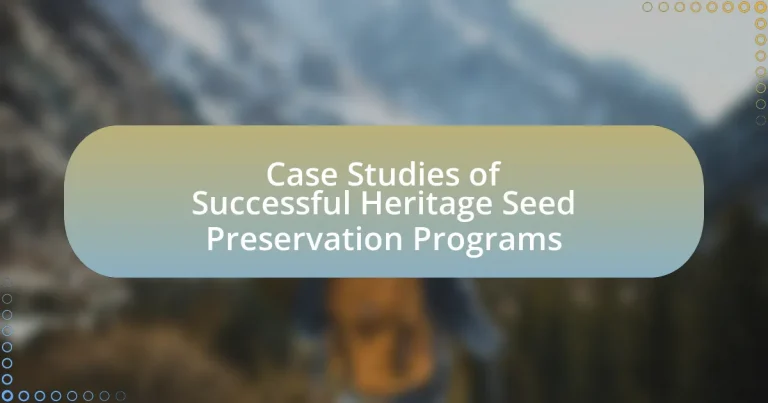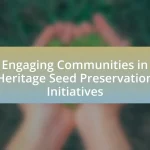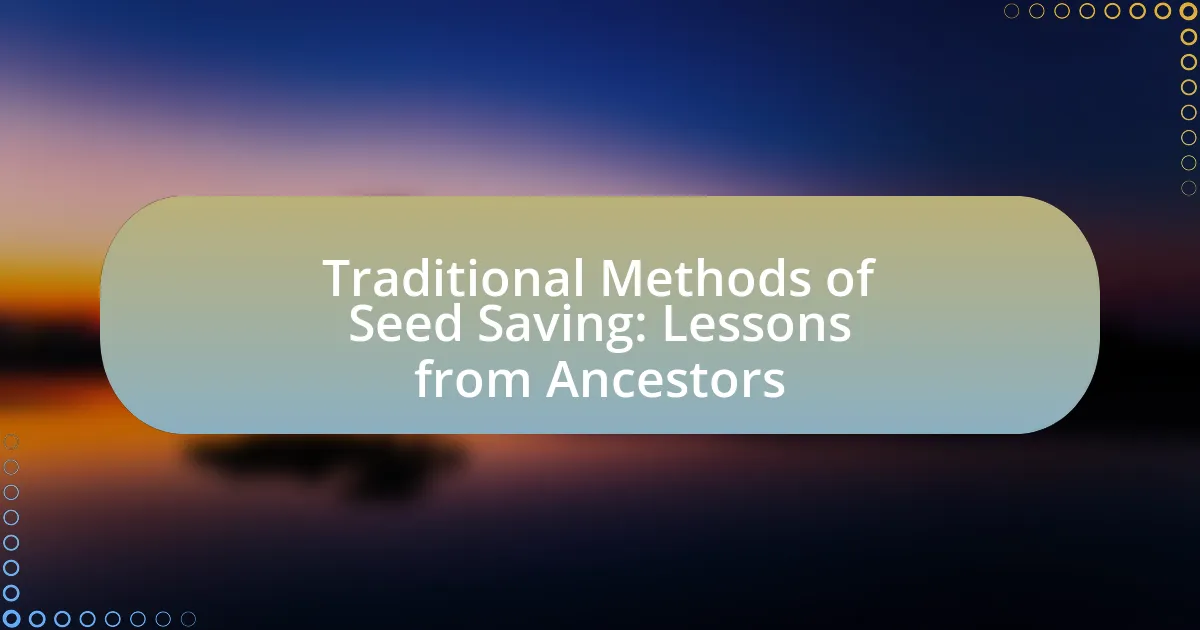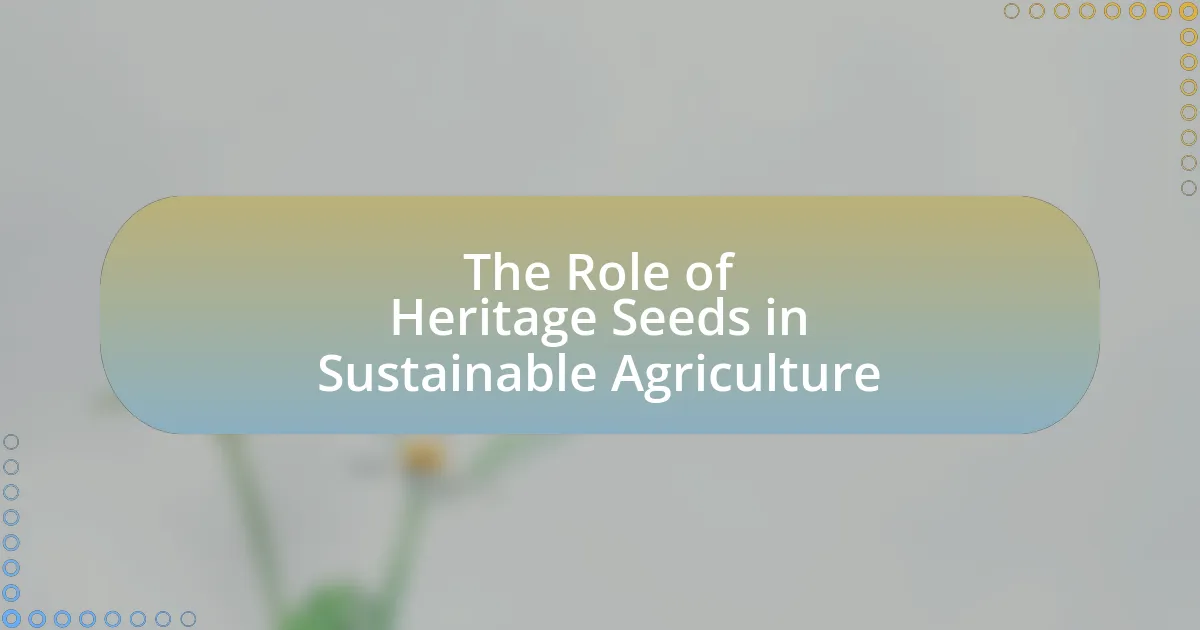Heritage Seed Preservation Programs are initiatives aimed at conserving traditional seed varieties to maintain genetic diversity, promote sustainable agriculture, and preserve cultural heritage. This article examines successful case studies, including the Seed Savers Exchange and Native Seeds/SEARCH, highlighting their strategies, community engagement, and the challenges they face. It also discusses the importance of heritage seeds for biodiversity, food security, and sustainable farming practices, while outlining practical steps individuals can take to support these preservation efforts. The role of technology and partnerships in enhancing the effectiveness of these programs is also explored.
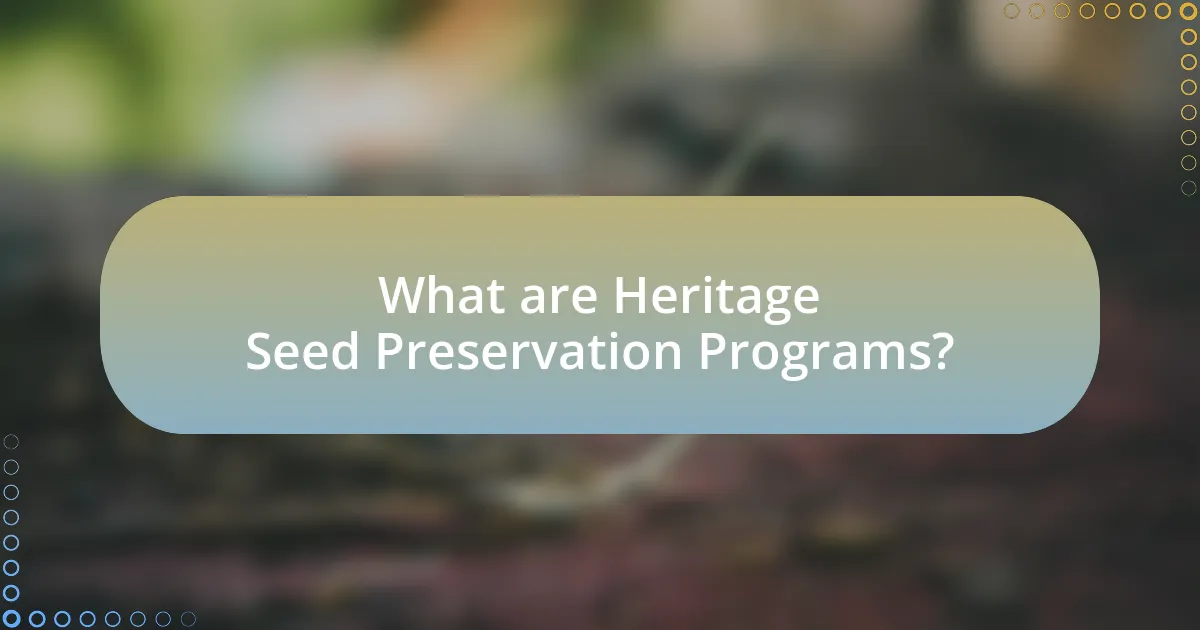
What are Heritage Seed Preservation Programs?
Heritage Seed Preservation Programs are initiatives designed to conserve and protect traditional seed varieties that have been cultivated over generations. These programs aim to maintain genetic diversity, promote sustainable agriculture, and preserve cultural heritage associated with specific crops. For instance, the Seed Savers Exchange, founded in 1975, has successfully preserved thousands of heirloom seed varieties, ensuring their availability for future generations and supporting biodiversity in agriculture.
Why are Heritage Seeds Important for Biodiversity?
Heritage seeds are crucial for biodiversity because they preserve genetic diversity within plant species, which is essential for ecosystem resilience and adaptability. These seeds represent traditional varieties that have been cultivated over generations, often adapted to local climates and conditions, thus contributing to a diverse gene pool. For instance, the preservation of heritage seeds can help maintain crop varieties that are resistant to diseases and pests, which is vital for food security. According to the Food and Agriculture Organization, about 75% of the world’s food diversity has been lost due to industrial agriculture, highlighting the importance of heritage seeds in maintaining agricultural biodiversity.
What role do heritage seeds play in maintaining genetic diversity?
Heritage seeds play a crucial role in maintaining genetic diversity by preserving a wide range of plant varieties that have adapted to local environments over generations. These seeds represent unique genetic traits that can enhance resilience against pests, diseases, and climate change, thereby contributing to agricultural biodiversity. For instance, a study by the Food and Agriculture Organization (FAO) highlights that heritage seeds can contain traits that are lost in modern hybrids, which often focus on uniformity and high yield. This genetic diversity is essential for food security and sustainable agriculture, as it provides a reservoir of genetic material that can be utilized in breeding programs to develop new varieties suited to changing conditions.
How do heritage seeds contribute to sustainable agriculture?
Heritage seeds contribute to sustainable agriculture by preserving genetic diversity and promoting resilience in crops. These seeds, often adapted to local climates and conditions, enhance biodiversity, which is crucial for ecosystem stability and agricultural sustainability. Research indicates that heritage seeds can improve soil health and reduce the need for chemical inputs, as they are typically more resistant to pests and diseases. For example, a study by the University of California found that farms using heritage varieties had a 20% higher yield stability compared to those relying on commercial hybrids, demonstrating their effectiveness in sustainable farming practices.
What Challenges Do Heritage Seed Preservation Programs Face?
Heritage seed preservation programs face several significant challenges, including funding limitations, genetic diversity loss, and climate change impacts. Funding constraints hinder the ability to maintain and expand seed banks, which are essential for preserving diverse plant varieties. Additionally, the loss of genetic diversity occurs as fewer farmers cultivate heritage seeds, leading to a reliance on commercial hybrids that may not be as resilient. Climate change further complicates preservation efforts by altering growing conditions, which can threaten the viability of certain seed varieties. These challenges collectively jeopardize the sustainability and effectiveness of heritage seed preservation initiatives.
What are the common threats to heritage seed varieties?
Common threats to heritage seed varieties include loss of genetic diversity, climate change, industrial agriculture practices, and the introduction of genetically modified organisms (GMOs). Loss of genetic diversity occurs when traditional varieties are replaced by a few commercial hybrids, reducing the resilience of crops. Climate change impacts growing conditions, leading to increased vulnerability of heritage seeds. Industrial agriculture practices often prioritize high-yield varieties, marginalizing heritage seeds and their cultivation. Additionally, the introduction of GMOs can lead to cross-contamination, threatening the purity of heritage varieties. These factors collectively jeopardize the survival and sustainability of heritage seed varieties.
How do economic factors impact heritage seed preservation?
Economic factors significantly impact heritage seed preservation by influencing funding availability, market demand, and agricultural policies. Limited financial resources can hinder the ability of organizations and farmers to maintain and cultivate heritage seeds, as these seeds often require more investment in terms of time and labor compared to commercial varieties. For instance, a study by the Food and Agriculture Organization (FAO) highlights that economic incentives, such as subsidies for organic farming, can encourage the cultivation of heritage seeds, thereby promoting their preservation. Additionally, market demand for unique and locally adapted crops can drive farmers to invest in heritage seeds, as seen in regions where consumers prioritize biodiversity and sustainability. Thus, the interplay of economic conditions directly affects the viability and sustainability of heritage seed preservation efforts.

What are Some Successful Case Studies of Heritage Seed Preservation?
Successful case studies of heritage seed preservation include the Seed Savers Exchange in the United States, which has preserved over 25,000 heirloom varieties since its founding in 1975. This organization focuses on collecting, preserving, and sharing seeds to maintain genetic diversity in agriculture. Another notable example is the Vavilov Research Institute in Russia, which houses a vast collection of over 300,000 seed samples, including many rare and endangered varieties, contributing significantly to global agricultural biodiversity. Additionally, the Svalbard Global Seed Vault in Norway serves as a secure backup for seed collections worldwide, safeguarding genetic material against global crises. These initiatives demonstrate effective strategies for preserving heritage seeds and ensuring agricultural resilience.
How did the Seed Savers Exchange achieve success?
The Seed Savers Exchange achieved success through a combination of community engagement, a strong focus on biodiversity, and effective seed conservation practices. By fostering a network of members who share and preserve heirloom seeds, the organization has built a robust repository of genetic diversity. This approach not only promotes sustainable agriculture but also educates the public about the importance of preserving heritage varieties. The Seed Savers Exchange has successfully documented and cataloged over 25,000 varieties of seeds, demonstrating its commitment to maintaining agricultural biodiversity and providing resources for future generations.
What strategies were implemented by the Seed Savers Exchange?
The Seed Savers Exchange implemented several key strategies to promote heritage seed preservation. These strategies include the establishment of a seed bank to collect and store diverse heirloom seeds, the organization of seed swaps to encourage community participation and sharing, and the provision of educational resources to inform the public about seed saving techniques. Additionally, the Seed Savers Exchange actively collaborates with local farmers and gardeners to maintain genetic diversity and promote sustainable agricultural practices. These efforts have contributed to the preservation of over 25,000 varieties of seeds, ensuring the availability of heritage crops for future generations.
What outcomes resulted from the Seed Savers Exchange’s efforts?
The outcomes of the Seed Savers Exchange’s efforts include the preservation of over 25,000 heirloom seed varieties and the establishment of a robust network of seed savers dedicated to biodiversity. This organization has successfully maintained genetic diversity in crops, which is crucial for food security and resilience against climate change. Additionally, the Seed Savers Exchange has fostered community engagement and education around sustainable agriculture practices, evidenced by their workshops and events that attract thousands of participants annually.
What lessons can be learned from the Native Seeds/SEARCH program?
The Native Seeds/SEARCH program teaches the importance of biodiversity conservation and community engagement in heritage seed preservation. This program emphasizes the need to maintain genetic diversity in crops, which is crucial for food security and resilience against climate change. By collaborating with local farmers and indigenous communities, the program fosters a sense of ownership and responsibility towards seed conservation. Additionally, it highlights the significance of education and outreach in raising awareness about the value of traditional agricultural practices. These lessons underscore the effectiveness of participatory approaches in preserving agricultural heritage and ensuring sustainable food systems.
How did Native Seeds/SEARCH engage local communities?
Native Seeds/SEARCH engaged local communities through collaborative seed-saving initiatives and educational programs. They organized workshops and events that focused on traditional agricultural practices, fostering a sense of community involvement and cultural heritage. By partnering with local farmers and indigenous groups, Native Seeds/SEARCH facilitated the exchange of knowledge and seeds, which helped preserve regional biodiversity and promote sustainable farming practices. Their efforts have resulted in increased awareness and participation in heritage seed preservation among community members, demonstrating the effectiveness of grassroots engagement in conservation efforts.
What impact did Native Seeds/SEARCH have on local agriculture?
Native Seeds/SEARCH significantly enhanced local agriculture by promoting the conservation and use of traditional seeds adapted to arid environments. This organization has facilitated the preservation of over 1,800 varieties of seeds, which are crucial for maintaining biodiversity and resilience in local farming systems. By providing access to these heritage seeds, Native Seeds/SEARCH has empowered local farmers to cultivate crops that are better suited to their specific climatic conditions, thereby improving food security and sustainability in the region. Additionally, educational programs and workshops offered by the organization have increased awareness and knowledge about sustainable agricultural practices, further benefiting local agricultural communities.
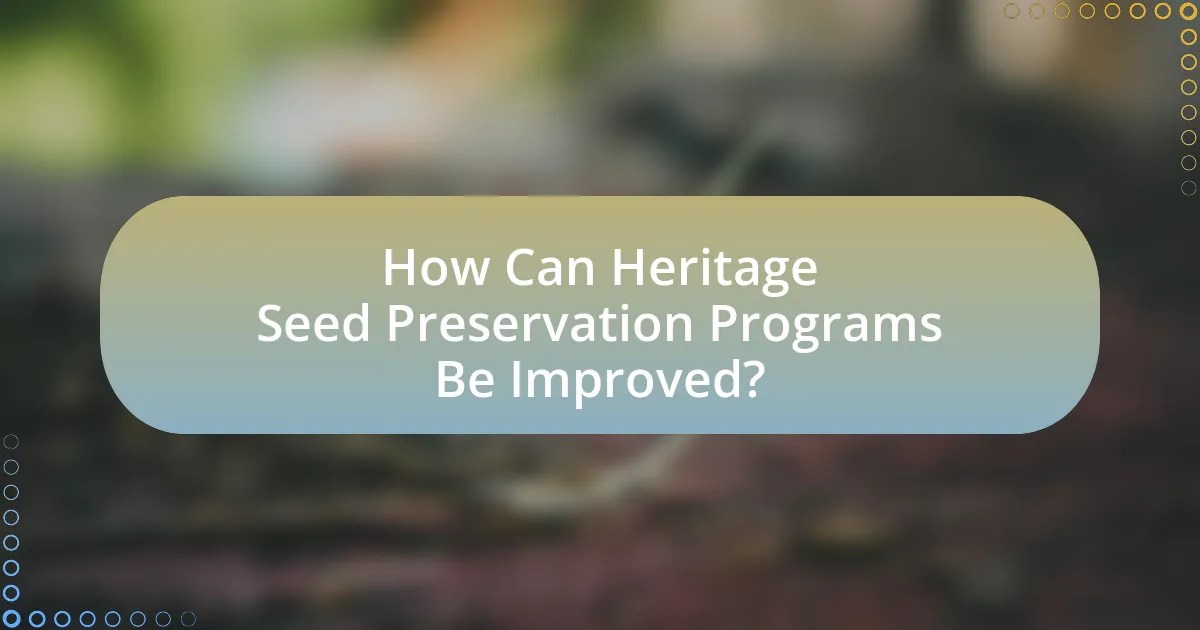
How Can Heritage Seed Preservation Programs Be Improved?
Heritage seed preservation programs can be improved by enhancing community engagement and education initiatives. Engaging local communities fosters a sense of ownership and responsibility towards seed preservation, which is crucial for the sustainability of these programs. For instance, programs that incorporate workshops and hands-on training in seed saving techniques have shown increased participation and knowledge retention among community members. Research indicates that educational outreach can lead to a 30% increase in local participation in preservation efforts, as seen in successful programs in regions like the Midwest United States. Additionally, establishing partnerships with local agricultural organizations can provide resources and expertise, further strengthening the effectiveness of heritage seed preservation initiatives.
What best practices can enhance the effectiveness of these programs?
Implementing community engagement strategies significantly enhances the effectiveness of heritage seed preservation programs. Engaging local communities fosters a sense of ownership and responsibility towards seed preservation, which has been shown to increase participation rates and program sustainability. For instance, the Seed Savers Exchange in the United States successfully involves local farmers and gardeners in seed saving, resulting in a diverse genetic pool and increased awareness of heritage seeds. Additionally, providing education and training on seed saving techniques ensures that knowledge is passed down through generations, further solidifying community involvement and program success.
How can technology be leveraged in heritage seed preservation?
Technology can be leveraged in heritage seed preservation through methods such as cryopreservation, digital databases, and genetic sequencing. Cryopreservation allows for the long-term storage of seeds at extremely low temperatures, effectively halting their aging process and maintaining genetic viability. Digital databases enable the cataloging and sharing of seed varieties, facilitating access to genetic information and promoting biodiversity. Genetic sequencing technology aids in identifying and preserving unique traits within heritage seeds, ensuring that valuable genetic resources are not lost. These technological advancements have been successfully implemented in various programs, demonstrating their effectiveness in preserving heritage seeds for future generations.
What role do partnerships play in strengthening preservation efforts?
Partnerships play a crucial role in strengthening preservation efforts by facilitating resource sharing, knowledge exchange, and collaborative action among stakeholders. These collaborations often involve non-profit organizations, government agencies, and local communities, which together enhance the effectiveness of preservation initiatives. For instance, the collaboration between the Seed Savers Exchange and local farmers has led to the successful preservation of diverse heirloom seed varieties, demonstrating how partnerships can mobilize community engagement and expertise to safeguard agricultural biodiversity. Such alliances not only amplify the impact of preservation efforts but also foster a sense of shared responsibility and commitment to heritage conservation.
What practical steps can individuals take to support heritage seed preservation?
Individuals can support heritage seed preservation by participating in seed saving, which involves collecting and storing seeds from heirloom plants for future planting. This practice helps maintain genetic diversity and ensures the availability of traditional varieties. Additionally, individuals can join or support local seed banks and community gardens that focus on heritage seeds, providing resources and education on their cultivation. Engaging in advocacy for policies that protect seed sovereignty and biodiversity also contributes to preservation efforts. According to the Seed Savers Exchange, over 1 million seeds have been preserved through community efforts, highlighting the impact of individual actions in maintaining heritage seeds.
How can home gardeners contribute to heritage seed conservation?
Home gardeners can contribute to heritage seed conservation by cultivating and saving heirloom varieties, which helps maintain genetic diversity. By growing these seeds, gardeners ensure that unique plant traits are preserved for future generations. Research indicates that heirloom seeds often possess better adaptability to local climates and conditions, making them valuable for sustainable agriculture. Furthermore, initiatives like Seed Savers Exchange demonstrate how community involvement in seed saving can enhance biodiversity and promote awareness of heritage crops.
What resources are available for those interested in heritage seeds?
Resources available for those interested in heritage seeds include seed banks, educational organizations, and online databases. Seed banks, such as the Seed Savers Exchange, preserve a wide variety of heritage seeds and provide access to them for gardeners and farmers. Educational organizations like the Organic Seed Alliance offer workshops and resources on seed saving and cultivation techniques. Additionally, online databases, such as the USDA’s National Plant Germplasm System, provide information on the genetic diversity of heritage seeds and their availability. These resources collectively support the preservation and cultivation of heritage seeds, ensuring their continued use and diversity in agriculture.
